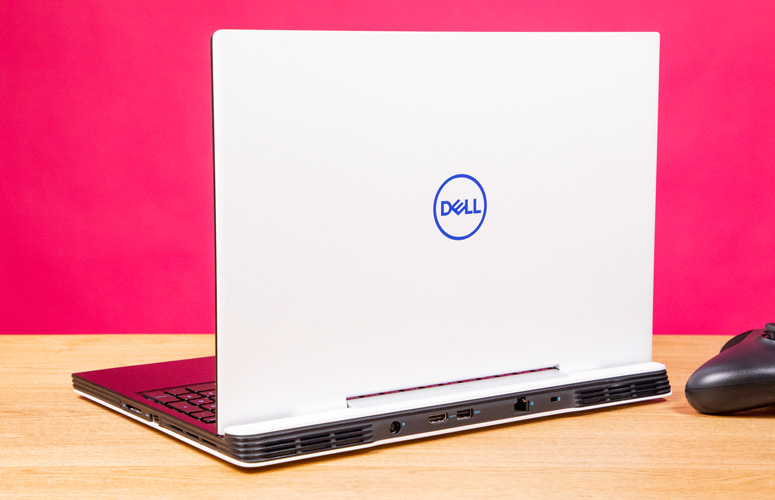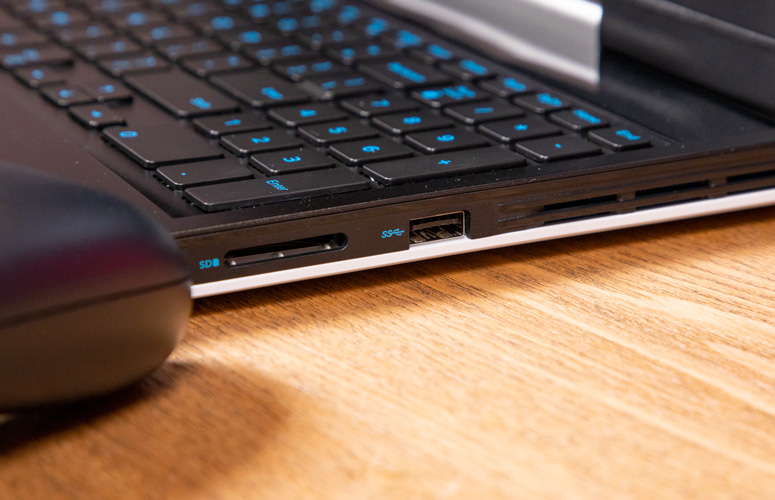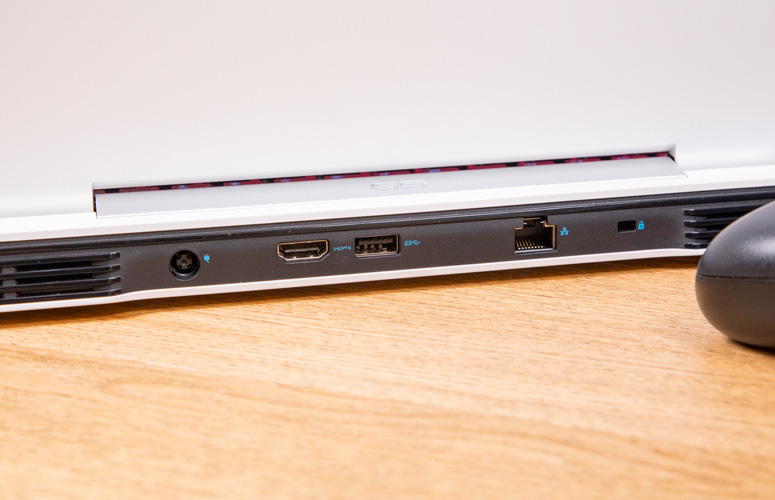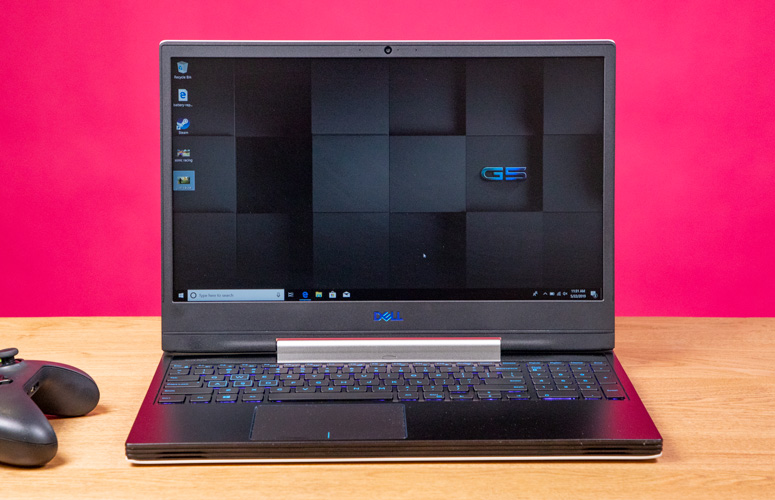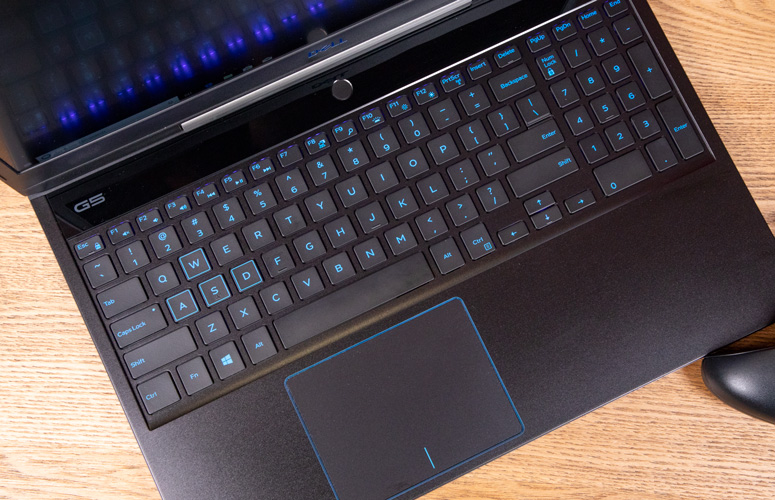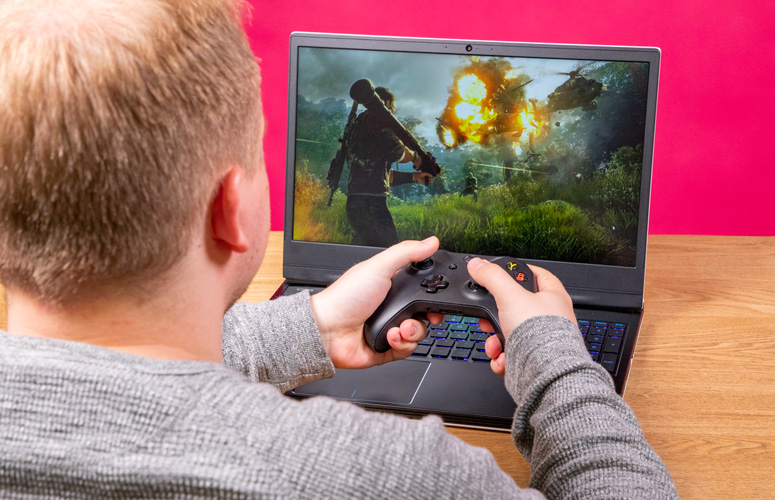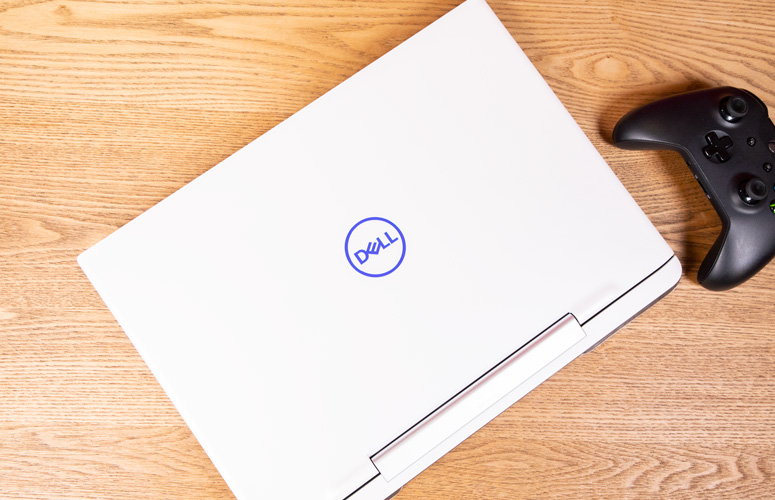Laptop Mag Verdict
With a vivid display and solid graphics performance, the G5 15 SE (2019) is a top-notch gaming laptop and a huge improvement over its predecessor.
Pros
- +
Stylish, premium design
- +
Vivid display
- +
Long battery life
- +
Good graphics performance
Cons
- -
Thick and heavy chassis
- -
Slow SSD
Why you can trust Laptop Mag
Dell's much-needed revamp to the G5 15 gaming laptop is a huge success. The redesigned system has a much-improved 15.6-inch, 1080p display that's nearly three times more colorful than the screen on last year's model. The new design is also sure to be a crowd-pleaser, especially on our Special Edition review unit, which flaunts a clean white lid and a neat glass window on the bottom.
Also noteworthy is the G5 15's new 9th Gen Intel Core i5 CPU and GTX 1650 GPU, which both offer good, if unremarkable performance. There's still room for improvement with the G5 15; the machine remains rather large, and its storage drives are painfully slow. Despite these flaws, the G5 15 is one of the best midrange laptops for casual gamers.
Dell G5 15 Pricing and Configurations
Dell was gracious enough to send us the special edition (SE) version of the G5 15, which has an Alpine White lid, with a glass cutout underneath that reveals a colorful heat-management system.
The base-model G5 15 SE costs $1,044 and comes with a Core i5-9300H CPU, 8GB of RAM, a 128GB M.2 PCIe NVMe SSD with a 1TB SATA HDD, and an Nvidia GTX 1650 GPU (4GB of VRAM). Our $1,068 review unit had the same components but double the SSD storage.
The $1,369 version is a big jump in both price and performance. That model packs a Core i7-9750H CPU, 8GB of RAM, a 256GB SSD + 1TB SATA HDD, and a GTX 1660 GPU. You also get a 15.6-inch display with a 144-Hz refresh rate, up from the 60 Hz in the lower-tier models. The $1,519 high-end model ditches the 144-Hz display but comes with a Core i7-9750H CPU, 16GB of RAM, a 512GB SSD and RTX 2060 graphics.
Not a fan of the Alpine White? Dell also offers similar configurations of the Deep Black nonspecial-edition G5 15 for less money.
Sign up to receive The Snapshot, a free special dispatch from Laptop Mag, in your inbox.
Design
Dell dialed back the "gamer" aesthetic of the previous model and gave the G5 15 a sleeker, more modern appearance.
The special edition we reviewed has the same Arctic White plastic lid we praised on the last-gen G7 15 (sadly, the 2019 version has a black-and-red color scheme), while the nonspecial edition has a Deep Space Black finish. Our unit's white lid looks clean and gives the laptop a certain allure that's missing in the overcrowded group of black-and-red laptops.
Matching the blue keyboard font and touchpad trim, a centered Dell logo on the lid shifts from indigo to chartreuse depending on how the light hits (the effect is pretty trippy). Also on the lid is a silver hinge with an embossed G5 logo.
Angled rear vents reveal stylish blue trim on the inside of this rig, while a stack of ridges wrapping around the chassis gives the G5 15 an aggressive stance when it's closed.
Unique to the special edition version of the G5 15 is a glass window on the bottom that reveals blue heat pipes and fan blades. Sure, it looks cool next to the white bottom panel, but I can't think of any good reason to look at the underside of a laptop.
MORE: Best and Worst Laptop Gaming Brands
That clean white finish is sadly absent on the inside of the laptop. Part of me wishes Dell had kept a consistent color scheme, while another part of me appreciates the cold, black aluminum deck, which feels more premium than what I'm used to in this price range. Dell made another major improvement in trimming down the display bezels. While not quite as narrow as those on the XPS laptops, these thin display borders keep the G5 15 relatively compact.
Still, I felt more embarrassed than I normally do when I used the G5 15 on the small table of a local Brooklyn coffee shop. That's because the G5 15 is rather bulky and heavy, measuring 1 inch thick, and weighing 5.6 pounds. Rival gaming laptops -- including the Lenovo Legion Y7000 (1.1 inches, 5.3 pounds), Acer Predator Helios 300 Special Edition (1.1 inches, 5.5 pounds) and MSI GF63 8RB (0.9 inches, 4.2 pounds) -- are about the same size but don't weigh as much.
Ports
The G5 15 has plenty of ports for connecting to monitors, docks and peripherals while charging other devices. Unfortunately, some of those ports (including the power jack) are on the back edge, which will frustrate some users.
On the right side of the G5 15, you'll find an SD card slot and a USB 3.1 port. The opposite edge houses a USB-C port alongside a second USB 3.1 port and a headphone jack. On the rear edge of the G5 15, there's an HDMI 2.0 input, a third USB 3.1 port, an RJ45 Ethernet port and a lock slot.
Only the RTX 2060 model offers Thunderbolt 3 and mini Display ports, so you'll have to pay up for future-proof connectivity.
Display
The new G5 15 SE's 15.6-inch, 1080p display is sharp, vivid and reasonably bright, which makes it a massive improvement over the previous model's disappointing screen. My review unit came with the standard 60-Hz display, but Dell also offers a 144-Hz panel that will make fast-moving objects look sharper.
The display was so detailed that I could see the tiny linkages between carburetors in a close-up shot of a Ford GT's engine in a trailer for the film Ford v Ferrari. Color also burst to life; the vinyl booths at a '60s diner shined a luscious red in the scene where Christian Bale and Matt Damon concoct their plan to take down Ferrari. Speaking of which, that iconic red finish on the Ferrari glimmered as the race car sped across my screen.
When I played Rise of the Tomb Raider, the blue ChemLight hanging off Lara Croft's belt loop glowed a rich neon blue, lighting up a dark cave with a calming aura. The deep scrapes and cuts across Croft's shoulder and arms oozed a deep scarlet that stood out against the lush earthen tones of the environment around her.
The G5 15's display covers 154% of the sRGB color gamut, which makes this screen almost three times more vivid than the display on last year's model. It's even more colorful than the displays on top competitors, including the Legion Y7000 (153%), GF63 8RB (73%) and Predator Helios 300 SE (113%).
MORE: The Best Gaming Laptops
The panel is also fairly bright, reaching 270 nits, which is right around the average for mainstream gaming laptops of 271 nits. The Legion Y7000's display (277 nits) was a bit more luminous, while the Predator Helios 300 SE (312 nits) breached the 300-nit mark. The G5 15 SE's display is brighter than the GF63 8RB's screen (246 nits).
Keyboard and Touchpad
If only all gaming keyboards were this comfortable. The G5 15's island-style keyboard is as good as you could ask for in a laptop of this price and size. The keys are nicely spaced and large despite the full-sized numpad found on the right size.
There's nothing fancy going on here; the keys aren't curved, mechanical or textured. In fact, with their flat, black keycaps, they remind me a lot of the keys on XPS laptops. Fortunately, the keys on the G5 15 offer a lot more travel than those on Ultrabooks, at 1.7 millimeters, which is above our 1.5mm preference.
The keys also provide the right amount of actuation force (66 grams), which gives them a firm clickiness. I didn't bottom out at all when writing this review, proving that the keyboard is comfortable enough to use during long typing sessions.
Our review unit came with blue-backlit keys, though I personally would spend an extra $30 for the optional four-zone RGB backlit keyboard.
I typed at 118 words per minute with an accuracy rate of 94% on the 10fastfingers.com typing test. That result is slightly slower and less accurate than my 119-wpm and 95% averages.
Once I got used to the offset positioning, I didn't run into any problems using the G5 15's 4.1 x 3.1-inch precision touchpad to execute Windows 10 gestures, like pinch-to-zoom and three-finger swipe to switch apps.
Audio
The dual forward-firing speakers on the front edge of the G5 15 can fill a medium-sized room, but they sound thin out of the box. You'll need to tinker with the Alienware Command Center to get the best audio quality.
When I listened to the song "What Once Was" by Her's, the late Stephen Fitzpatrick's delicate vocals were clear but got swallowed by the electric guitar. In fact, the entire song felt hollow and recessed. Increasing the Vocal Clarity, Treble Enhancer and Bass Boost controls in the Command Center app gave the song a bit more life, but the speakers still lacked energy.
MORE: Can I improve my headphone experience while gaming?
Those speakers seem to be optimized for gaming, because the caves in Rise of the Tomb Raider had an eerily convincing echo as I scurried through the darkness as Lara Croft. When the floor gave out from underneath my character, the loud, booming sound of rocks crashing against each other almost made me jump.
Gaming, Graphics and VR
The G5 15 is the first laptop we've reviewed that comes armed with Nvidia's new GeForce GTX 1650 GPU with 4GB of VRAM. For context, the GTX 1650 is a step up from the GTX 1050 found in most budget gaming laptops and premium performance machines, but it doesn't quite offer GTX 1060 performance on most games.
Regardless, I played Rise of the Tomb Raider at a steady 31 frames per second on Very High graphics settings. At a few moments, the game dipped below our 30-fps playability threshold. But I still didn't experience any lag or stuttering, even as I swam through lakes and climbed up ruins.
We saw mixed results on our gaming benchmarks, with the G5 15 outperforming competitors on some games but falling far behind on others. Hitman was one game in which the G5 15 did quite well, producing 85 frames per second (1080p, Ultra). It's higher than the category average (78 fps) and the scores from the Legion Y7000 (70 fps, GTX 1060 GPU), GF63 8RB (69 fps, GTX 1050Ti) and Predator Helios 300 SE (72 fps, GTX 1060).
The G5 15 didn't have any trouble with Rise of the Tomb Raider either. With a steady rate of 37 fps, the G5 15 matched the Legion Y7000 and outperformed the GF63 8RB (27 fps). The Predator Helios 300 (38 fps) and the average gaming laptop (44 fps) played Tomb Raider at an even faster pace.
MORE: Is Intel's Coffee Lake Worth It for Gaming Laptops?
Unfortunately, the G5 15 SE's GTX 1650 GPU slumped in the Metro: Last Light benchmark, maintaining only 29 fps, which is below our 30-fps threshold. While that matches the GF63 8RB, the Legion Y7000 (46 fps), Predator Helios 300 (48 fps) and average mainstream gaming laptop (48 fps) all ran the game with more frames to spare.
The same goes for Middle-Earth: Shadow of War (Ultra, 1080p), which the G5 15 played at 47 fps. Yes, that's more than playable, but the Legion Y7000 (69 fps), Predator Helios 300 (75 fps) and average mainstream laptop (67 fps) surpassed the Dell. The GF63 8RB (44 fps) struggled on this benchmark.
The G5 15 SE isn't the best laptop for virtual reality. The system scored a 5.6 on the SteamVR Performance Test, a mark that falls short of the mainstream average (7.9) and results from the Predator Helios 300 (7.9) and Legion Y7000 (7.0)
Performance
Armed with an Intel Core i5-9300H CPU and 8GB of RAM, the G5 15 has enough power to run anything but the most demanding tasks. I replaced my work machine with the G5 15 for a day and didn't run into any performance hiccups, even when I simultaneously watched an Overwatch stream and the Women's World Cup group stage. There wasn't any lag when I loaded 20 Google Chrome webpages while playing four 1080p YouTube videos.
That said, if you're a photographer, videographer or someone who frequently transfers large files, then the G5 15 isn't for you. That's because the G5 15's sluggish 1TB 5,400-rpm HDD and 256GB M.2 PCIe NVMe SSD needed 39 seconds to complete our file-transfer test (duplicating 4.97GB of mixed-media files), for a disappointing rate of 130.1 megabytes per second. That's magnitudes slower than the hard drives in the Legion Y7000 (636 MBps, 256GB SSD), GF63 8RB (318 MBps, 256GB M.2 SSD) and Predator Helios 300 (363 MBps, 256GB PCIe NVMe SSD). The category average is a much speedier 390.8 MBps.
MORE: Laptops with the Best Overall Performance
The G5 15 did reasonably well on our other performance tests, although its 9th Gen Core i5 CPU couldn't keep up with 8th Gen Core i7 processors in rival systems. The G5 15 scored a 16,722 on the Geekbench 4.3 test, which is considerably worse than what the Legion Y7000 (Core i7-8750H, 22,474), GF63 8RB (Core i7-8750H, 21,811) and Predator Helios 300 (Core i7-8750H, 20,595) achieved.
We saw similar results on the HandBrake test, in which the G5 15 took a leisurely 14 minutes and 31 seconds to transcode a 4K video into 1080p resolution. Other mainstream gaming laptops completed that task near or below the 10-minute mark, as happened with the Legion Y7000 (9:34), GF63 8RB (10:20) and Predator Helios 300 (10:30). The category average (10:25) is right around 10 minutes, as well.
Battery Life
Gaming laptops have a bad rap when it comes to battery life, but every now and then we come across a rare gem that defies the stereotype. The G5 15 is one of those precious stones. This gaming rig endured for 6 hours and 53 minutes on the Laptop Mag battery test, which involves continuous web surfing over Wi-Fi at 150 nits.
That may not sound like a long time, but other gaming laptops power down after just a few hours, as proven by the paltry mainstream gaming laptop average of 4:07. The Legion Y7000 (4:28), GF63 8RB (3:30) and Predator Helios 300 SE (3:00) shut down several hours before the G5 15.
I risked testing the G5 15's runtime by bringing the chunky machine to a coffee shop without a charger, and I was happy to get 6 hours of work done before I had to head back home to juice the machine back up.
Heat
The glass panel on the bottom of the G5 15 looks great, but it gets hot when the laptop is lifting a heavy workload. Apart from that area, which reached 101 degrees Fahrenheit after we played a 15-minute, 1080p video in full-screen, the laptop remained reasonably temperate. The touchpad peaked at 84 degrees, while the center of the keyboard and bottom panel were only slightly above our 95-degree comfort threshold, at 96 degrees and 98 degrees, respectively.
The G5 15 predictably rose in temperature after we played a session of Rise of the Tomb Raider. The touchpad was a comfortable 78 degrees, while the keyboard (100 degrees) and bottom panel (108 degrees) were warm but never hot to the touch.
Webcam
You won't want to use the G5 15's 720p webcam to host a stream. The image quality isn't anywhere near good enough. In fact, I've seen budget laptops with better webcams than this. My face looked grainy, and the hanging lights above my head were completely blown out in a selfie I snapped in our dimly lit office. It's not that the lens can't capture details -- I could easily make out individual strands of hair in my beard -- it's just that all the visual noise makes objects look smeared.
Software and Warranty
If you plan on downloading a bunch of games on the G5 15, then start by uninstalling the bloatware that comes preinstalled on this system. That includes some Microsoft staples, such as the Candy Crush Saga games, LinkedIn and the Solitaire Collection.
To its credit, Dell didn't put any extraneous programs on the G5 15. For gamers, the most notable addition is the Alienware Command Center, where you can launch games; monitor CPU, GPU and memory usage; and adjust the audio controls. Unfortunately, I wasn't able to test the AlienFX lighting-control system, because my specific G5 15 model didn't come with an RGB keyboard.
MORE: Best Graphics Performance
Other apps courtesy of Dell include Mobile Connect, which lets you connect and operate your smartphone from your laptop. You'll also find a power-management app, a cloud-storage service and a customer service program. Of course, you get Nvidia's Control Panel program, too, and a pair of Intel apps for integrated graphics controls and memory/storage management.
The G5 15 comes with a one-year limited warranty. See how Dell performed on our Tech Support Showdown, Best and Worst Brands, and Best and Worst Gaming Laptop Brands rankings.
Bottom Line
There's nothing better for a laptop reviewer than testing a product that improved by leaps and bounds over its predecessor. Dell clearly identified the shortcomings of the previous G5 15 and was proactive about fixing them. By far the biggest upgrade is the display, which evolved from one of the worst on a gaming laptop to one of the best of any notebook in this price range.
Additionally, the laptop's GeForce GTX 1650 graphics and 9th Gen Intel CPU offer solid performance, whether you're gaming or browsing the web, and the redesigned chassis feels premium and looks great. However, the G5 15 has a few blemishes that keep competing gaming laptops, like the Lenovo Legion Y7000, in contention. For one, the G5 15 is bulky and heavy, despite the new chassis. And the laptop's HDD+SSD combo is inexcusably sluggish, which is a turnoff to anyone who transfers large files at work.
But overall, the G5 15 is a very good midrange laptop for casual gamers who want a system with a beautiful display and long battery life that sells at a reasonable price.
Credit: Laptop Mag
Dell G5 15 SE (2019) Specs
| Bluetooth | Bluetooth 4.2 |
| Brand | Dell |
| CPU | Intel Core i5-9300H |
| Card Slots | 2-1 card reader |
| Company Website | https://www.dell.com/en-us |
| Display Size | 15.6 |
| Graphics Card | Nvidia GeForce GTX 1650 |
| Hard Drive Size | 256GB |
| Hard Drive Type | M.2 PCIe NVMe SSD |
| Highest Available Resolution | 1920 x 1080 |
| Native Resolution | 1920x1080 |
| Operating System | Windows 10 Home |
| Ports (excluding USB) | SD card slot, Lock Slot, Headphone/Mic, HDMI 2.0, USB Type-C, USB 3.1 Always-On, USB 3.1 |
| RAM | 8GB |
| RAM Upgradable to | 16GB |
| Secondary Hard Drive Size | 1TB |
| Secondary Hard Drive Speed | 5,400 rpm |
| Secondary Hard Drive Type | SATA Hard Drive |
| Size | 14.3 x 10.8 x 1 inches |
| Touchpad Size | 4.1 x 3.1 inches |
| USB Ports | 4 |
| Video Memory | 4GB |
| Warranty/Support | one year warranty. |
| Weight | 5.6 pounds |
| Wi-Fi | 802.11ac |
| Wi-Fi Model | Intel Wireless-AC 9560 |
Phillip Tracy is the assistant managing editor at Laptop Mag where he reviews laptops, phones and other gadgets while covering the latest industry news. After graduating with a journalism degree from the University of Texas at Austin, Phillip became a tech reporter at the Daily Dot. There, he wrote reviews for a range of gadgets and covered everything from social media trends to cybersecurity. Prior to that, he wrote for RCR Wireless News covering 5G and IoT. When he's not tinkering with devices, you can find Phillip playing video games, reading, traveling or watching soccer.

